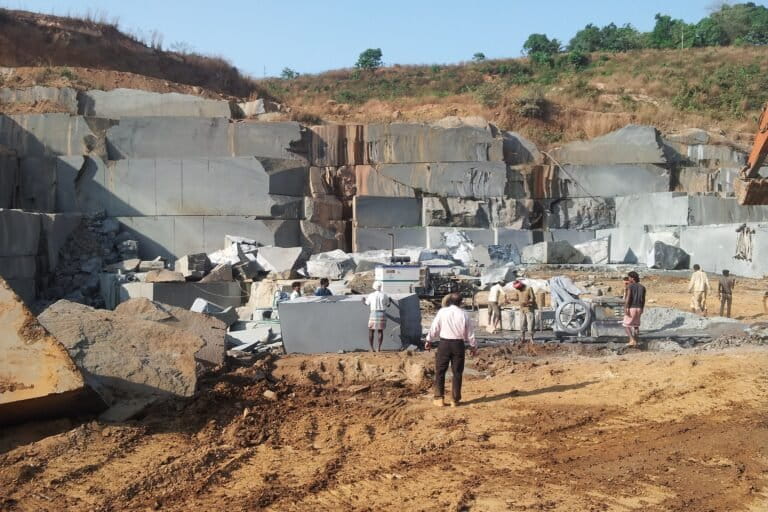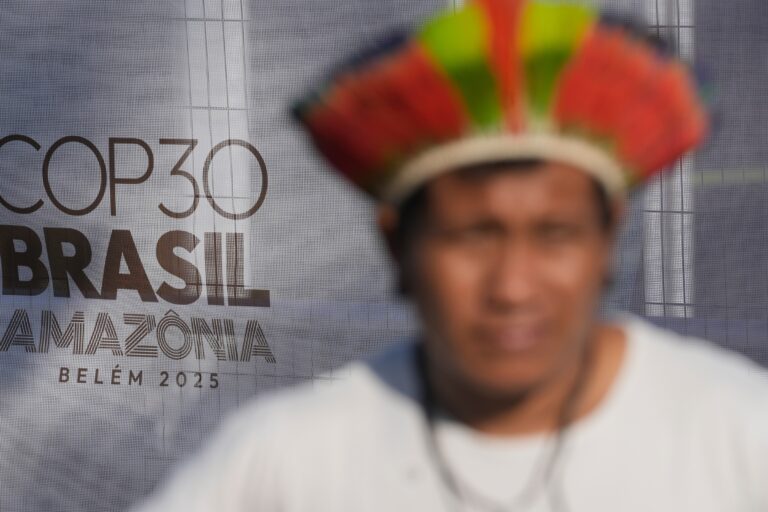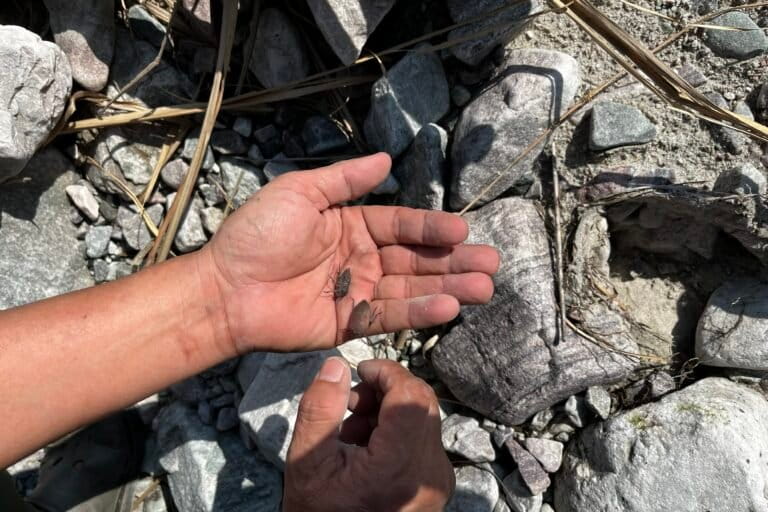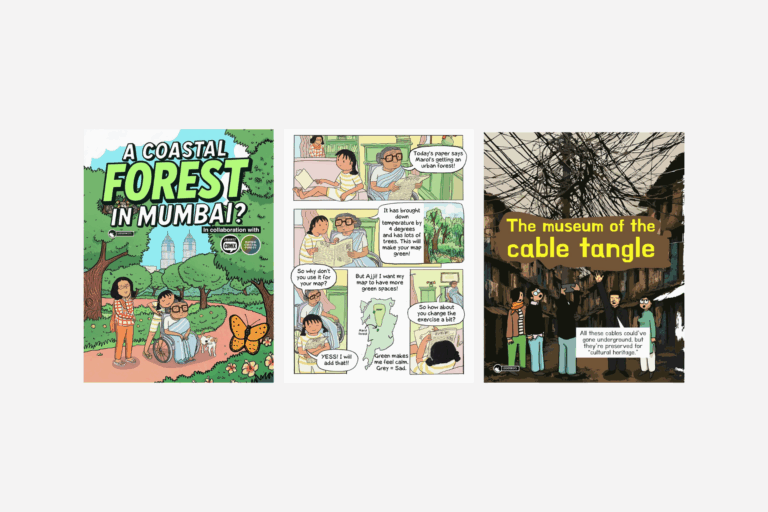- In the second episode of the podcast GigaWhat, we explore the land conflict challenges in India caused by renewable energy projects.
- The issue of common lands not being properly surveyed and recorded, and the people’s rights over these lands not properly defined is discussed by the expert speakers. They highlight the need for transparency in data about land ownership and rights.
- Environmental and Social Impact Assessments for large renewable energy projects is discussed as a possible solution to avoid land conflicts.
Renewable energy projects require vast tracts of one limited resource – land. The second episode of Mongabay-India’s podcast series, GigaWhat, explores the challenges of land conflicts and renewable energy projects.
Land disputes are a serious concern as large-scale renewable energy projects are planned across India. According to research, sustainable energy initiatives, mostly wind and solar, are already causing disputes in different parts of the country. As India gears to meet the 450GW clean energy target by 2030, the issue of land becomes an important topic.
Contributing Editor, Mongabay-India and the podcast host, Mayank Aggarwal, speaks to experts in the industry to understand how the critical resource land is being used and how socially just the renewable energy projects truly are. The conversation among Karthik Ganesan (Fellow and Director of Research Coordination, Council on Energy, Environment and Water), Mrinali Karthick (Database and Collaborations Lead, Land Conflict Watch), Leo Saldanha (Environment Support Group), Sikari Rongpi (Farmer, Mikir Bamuni) and Kawe Ingtipi (Resident, Mikir Bamuni), throws light on the current land conflicts caused by renewable energy projects, challenges in meeting clean energy targets and possible solutions.
Listen here:

Read more: GigaWhat episode 1: Clean Waste
Full transcript:
Mayank Aggarwal (MA): You are listening to Everything Environment by Mongabay-India.
Let’s visualise the sheer expanse of one of India’s largest solar parks — the Pavagada Solar Park in Karnataka. An aerial view of the site shows a never-ending sea of glass panels and wires spread across 13,000 acres. That is about 1/4th of the size of Kolkata city.
Then there are smaller solar and wind power plants too. Some are even a fraction of Pavagada solar plant. These power projects that harness unlimited sunlight and wind need another critical resource, a limited one – land.
Land is essential to install solar panels, wind turbines and transmission lines.
And in a country such as India, land is scarce. Most of the land is used by people in one way or another. Most of the land has a human footprint. It could be private or community farmland. Or it could be the village pasture where cows and sheep graze, or it could be a parcel of land that’s considered sacred for centuries and worshiped by communities.
In the race to achieve clean energy targets, the pressure falls on such land parcels beyond city boundaries and the people who depend on them. It’s well acknowledged by the government, renewable energy companies and all stakeholders in the sector that land availability and acquisition are critical challenges in renewable energy projects.
On the other hand, communities risk losing rights and access to land with unfair or no compensation. So how sustainable and just, are clean energy projects in their current form?
I am Mayank Aggarwal, Contributing Editor at Mongabay-India. We are an online publication dedicated to bringing you stories on science and the environment in India.
In our special podcast series, GigaWhat, we will explore some of the biggest questions, challenges, and opportunities in India’s transition from fossil fuels to clean energy sources.
Karthik Ganesan (KG): Land at the end of it, is probably one of the most contested resources that’s available to, you know, humanity.
This is Karthik Ganesan, Fellow and Director of Research Coordination at Council on Energy, Environment and Water or CEEW. He has over a decade’s experience and has worked on areas ranging from energy access to sustainable mobility.
KG: In a country like India, which hosts, you know, close to 16% of the world’s population, but in terms of, you know, area is a much smaller share. So, obviously, you know, the pressures on land are very different here, and on a different scale. And, to me, you know, as a researcher who’s really interested in driving a sustainable energy system, the most important thing that comes to my mind is availability of land, the ease with which, you know, a potential project winner is able to access it.
KG: The technology keeps evolving. So, about, I would say in recent years, you know, about every wind project per megawatt requires about 1.5 hectares of land, right, and a megawatt of solar requires about two megawatt two hectares of land, right. What our most recent research says, is that between 2050 and 2100, that requirement for, you know, solar plus wind, right, largely because we largely going to be a solar plus wind driven energy system, if you had to transition to a netzero system, would be anywhere, you know, grow from about 3% of overall land to about 6% which is not not a trivial number at all.
MA: Net-zero emission is not just a buzzword. The term fundamentally means balancing out the carbon dioxide we let out in the air. This is important in the global fight against climate change. And to reach net-zero targets, nations are turning to renewable energy sources.
India’s Prime Minister, Narendra Modi’s speech at the 2021 climate change summit or CoP26 made big headlines. He announced India’s goal to reach net-zero emissions by 2070 and to meet 50% of its electricity requirements from renewable energy sources by 2030.
According to the research Ganesan referred to earlier, for India to reach net-zero between 2050 and 2100, it will need to allocate 3% of its total land, which is almost the size of Bihar to 6% of its land, which is nearly the size of Gujarat for renewable energy generation.
KG: It might seem very small in the scheme of things, but then our first foray into this really looked at what is the impact of land in a state like, for instance, Rajasthan. Despite the land availability, what really was a challenge there was to envision the amount of water for instance that is required in the process of cleaning solar panel’s right and how would he compete With the needs for water for, you know, livelihood and daily needs of the people in the in those areas.
And even though the, you know, the land footprint is very small, ultimately what the bottleneck ends up happening in those kinds of areas is it’s competing for a much more precious resource, which is water. Right? So I guess, in no context, is the land alone, the bottleneck.
Mrinali Karthick (MK): So a land conflict, we define as any instance in which two or more parties contest the use of access to or control over land, and its associated resources.
We spoke to Mrinali Karthick from Land Conflict Watch, an independent agency tracking natural resource conflicts in India. They aim to facilitate better decision-making on investments and governance. Karthick works with researchers and journalists to understand and analyse the land conflict data they gather.
MK: So if there is a company that wants to set up an industry on a piece of land, which people either own or are dependent on, there is a conflict comes up when the people do not want to part with the land on the terms set by the company or the government.
And predictably most, in most cases, the victims of these land conflicts are members from marginalised communities. So it’s usually people from oppressed castes, tribal communities and women.
MA: Can you provide a little snapshot of the total land conflict cases that you have documented so far, including the number of people who are affected, the land which is involved, or the investments that are at stake?
MK: So we collect around 50 parameters for each case, we do collect 50 data points. And this includes data on what the community is demanding and what they’re fighting about. And it also includes data on what the companies and the government say. So our data does include both sides of the conflict.
MK: So, over six years Land Conflict Watch has documented around 781 cases. This includes conflicts, which are both ongoing and conflicts which have been resolved. And these 781 cases affect around 7.5 million people across the country and involves investments of over 2.7 trillion rupees. With respect to renewable energy, so Land Conflict Watch, as of now, has around nine cases in our database. These renewable energy projects have affected around 2,300 people and involve investments of around 9,305 [crores]. So these are just figures for eight or nine cases. So the actual numbers are definitely much more than this.
MK: And these are not just limited to what the renewable energy ministry calls the eight renewable energy rich states, we also see conflicts outside the states like Assam and Kerala etc. Most of these conflicts have been because either because of non-payment of compensation, which was due to the people or because of encroachment by, you know, these renewable energy companies, or in some cases, forceful evictions as well.
MA: An ongoing case of land conflict has been brewing in Assam’s Mikir Bamuni village, roughly 150 km west of Guwahati. The village, which mainly depends on farming and is home to ethnic Karbi and Adivasi communities, was chosen as a site for a small 15-megawatt solar plant.
But issues over land acquisition have stirred resistance, protests and even violence. Villagers allege that the district authorities forcefully evicted people from cultivable lands that they have been tilling for generations.
Mongabay-India contributor Nabarun Guha met some villagers and saw the fenced solar plant standing amidst paddy fields.
Sikari Rongpi (SR), a farmer from Mukir Bamuni village spoke to us.
SR: When the company officials came to our village in 2019, they proposed through some middlemen that they wanted to set up a solar power plant in our village for which they needed our land. We said we wouldn’t give our land as we use it for cultivation. We have ryot khatiyan in our grandfather’s name. We have been tilling this land for four generations. They told us that they would make our land miyadi.
MA: Khatiyan is the legal document that declares inheritable occupancy rights over land. In Assam, a tenant who has cultivated land continuously for three years is eligible for occupancy rights. Converting it to miyadi makes the land eligible for transactions in the state.
SR: They also said that they would leave out the playground, burial ground and place of worship from their proposed plan for the solar plant. They said if we give them our land, they will pay us for the yield we grow. We said we produce 15 mounds of rice per bigha. They said they would pay us the price of 12 mounds per bigha. If one mound costs 500 rupees, they will pay us that price for the next 25 years if the company is here. However, as we disagreed, they tried to take our land forcibly. We were given a notice that we needed to give up our land. We said we wouldn’t. They said we don’t have rights over this land. We said in that case, why are you offering money to someone who doesn’t have rights over the land?
Kawe Ingtipi: My name is Kawe Ingtipi and I’m from this village. On 24th December, they brought the tractor forcibly inside the boundary. We were working in our fields. They demolished the crops. We got into a quarrel with the police and people from the company. On 29th December, cops blocked the road which we use. We told them that they couldn’t close down the road. They would have to open the gate. But they forcibly put up a fence and blocked the road. As our arguments heated up, police started a lathi charge. Some people were injured while one pregnant lady from our village suffered a miscarriage due to the beating. Sixteen women from our village were beaten up.
MA: A report by the Delhi Solidarity Group titled “The Anatomy of A Solar Land Grab” states that land transfer didn’t follow the law and didn’t consider the land rights of the indigenous communities.
Leo Saldanha (LS), part of an NGO Environment Support Group and one of the report’s authors, also spoke to Nabarun Guha.
LS: So the problem is in Mikir Bamuni is one more instance where we have seen that solar park is in no way you know, environmentally benign. We have been saying this for almost a decade now. Because we said it first in the country in 2012. When we raised this concern, in the way in which solar parks were being set up in Challakere in Karnataka; 1,500 acres was being diverted to a park and we asked questions of what this means to the pastoralists to the agriculturist, who are losing their commons, grazing commons in that case. We have similarly asked the question in Pavagada where about 13-14,000 acres was diverted. Private agricultural land and also commons and forests.
And in each of the situations, what we have seen is that there is absolutely no understanding of the direct impact it has on environment and society, because there’s no effort to and in fact we challenged the Minister of Environment and Forests, who took a decision that since it is solar and since there is no smoke coming out and therefore it must be all good. You know, that kind of naive, simplistic analysis was the basis on which the ministry passed the circular, saying solar parks don’t need to go to environmental review. As a result, once you want to set up a solar park, you just go to the energy office, get your license, check your land and get going.
MA: In a letter available online, the solar company claims that it followed all legal processes, acquired the land from its rightful private owners and did not instigate violence.
The construction of the solar plant is slow but in progress, but the issue hasn’t been settled yet.
The complexities in land ownership in the country, land scarcity and often, the lack of transparency between stakeholders, and public consultation process in land acquisition have been the main reasons for years of conflicts between private companies, government and the people. These cases exist across industries: mining, manufacturing, and now, renewable energy.
MK: So the main focus when we analyse and put out our inference from our data, is that there’s a huge chunk of investments that are stuck in these conflicts, which is why we need to address the issue of land conflicts as soon as possible. Because as conflicts continue to extend over time, we’ve noticed that the investment required in these projects also keep increasing over the years. So there is definitely not just investments getting stuck, but over years, there is an increase also in the required investment for these projects.
So in most of the analysis that we’ve carried out, we found that conflicts involving common lands are the most.
MA: Commons are resources accessible to communities and to which no individual has exclusive ownership. Areas such as grazing grounds and tanks that people use for farming or fishing fall under commons.
MK: This is usually because these common lands are not properly surveyed and recorded, and the people’s rights over these lands are also not properly defined. And this has therefore led to an increase in the number of conflict cases on common land. So we noticed a similar pattern, even in conflicts related to renewable energy projects.
In fact, you would be knowing that solar and wind power do need large tracts of land. And since there’s no proper policy framework, you know, to govern the takeover of common lands, or to ensure that fair compensation is given to people who are dependent on these lands, these common lands are, according to the government most easily available land, because the government can take over these lands by paying a small pittance, or in many cases, they don’t have to pay anything at all. So people, you’re not dependent on these lands, usually women, oppressed class and tribal communities, they don’t get adequate compensation when they part with the land. And so, they try to resist the takeover of these lands. So this leads to protests and conflict.
MA: According to Ganesan, when companies don’t get a clear picture of who owns their desired plot of land and how they use it, it sparks trouble.
KG: What we are classifying as wasteland today, it is not necessarily a wasteland, it could have been, could have been a grassland for all you know, right, which was, which had a thriving ecosystem on its own. But then, you know, because you know, the land the government records classified is wasteland, we sort of end up assuming that it’s available. But then when we go close to the ground, we find that there are alternate use cases, there is biodiversity impact. And that is something that I feel like the energy researchers, the community that I belong to, right, of course, there are colleagues of mine who do models, it’s very difficult to integrate all of these different land use problems, our challenges and bottlenecks into sort of like a system level model that assesses what the land footprint and the land requirements are to satisfy the energy needs of the country. So what we all invariably stick to is just that, you know, okay, per megawatt you require this much, you might have some sort of like geographic distribution of where that land parcels will be, but we rarely ever consider, right, the underlying use cases. And that, I think, is increasingly happening.
KG: I think the first thing that is needed is for us to sort of really map out what is the priority parcels that are actually available for the various you know, renewable energy projects, whether it is solar or for wind?
So the problem that I’m alluding to Mayank is that, I think we need to have a much more transparent system, where data pertaining to resource availability, right, the land use, currently in those areas where that resource has been detected, right, the land ownership associated with that, like, all these three different layers are actually made available to potential developers, right, you know, for a fee when they’re bidding, right, I mean, our agencies, right, whether it’s our remote sensing agencies, whether it’s a renewable energy development agencies, they need to ensure right, the National Institute of Wind Energy (NIWE) or you know, NISE (National Institute of Solar Energy) right, all of them they need to ensure that this data is actually available, so that we’re ultimately putting our money behind the most efficient parcels of land.
And unless you sort of have all of these coming together, right, which then on top of which, you have to then superimpose the constraints of the electricity network being able to reach those spots, right, and how cost effective is it to sort of you know, reach the nearest substation, where this electricity will be pulled in to then you know, be fed into the broader grid? Right, those assessments need to happen in an integrated manner.
MA: With an image of being ‘green’ and ‘clean’, wind and solar energy projects of all sizes are exempt from obtaining Environmental Clearance, a step mandatory for projects like coal power plants.
KG: Nobody thought we would be where we are and where we plan to go, even 10 years back, right, our target of 175 was set, you know, seven years back. Right? in 10 years back, we were aiming to have 20 gigawatts in all. So you know, the pace of progress is obviously you know, outstripped anybody’s imagination. But nevertheless, I think that’s not an excuse for us to not have thought about the broader imperatives of ensuring that, you know, the conflict between the different use cases for land should be addressed actively through policy, and as you rightly said, right, just as in the case of, you know, other infrastructure, whether it’s, you know, mining or thermal power plants, or any other large infrastructure, we need to have a more clear process of addressing what, you know, land related issues are through specific policy, right, whether it’s through social impact assessment or an environmental impact assessment or both of them together to then determine, right, is this really the best course of action?
So, it is very important that I think we have that, you know, social impact assessment, as well as an environmental impact assessment in place. And ultimately, way up, you know, under the communities are aware what they’re signing up for, and what this will mean for their livelihoods, and their landscapes and their sort of customs and practices that they’ve had for hundreds, if not 1000s of years.
MA: Do you think that there are other solutions? Like do you think that solar rooftops for that matter, or say offshore wind farms, or say floating solar parks, do you think that these can be the alternatives to solving these land issues?
KG: Absolutely, I mean, I think this is, these have, of course, been thought of, and I think from the perspective of, you know, distributing the burden of, you know, of having to, you know, convert the entire energy system to a renewable energy one, distributed renewable energy, by way of, you know, rooftop solar, you know, and, you know, home-based solar systems, right, are obviously the ideal thing. But in reality, we know that a lot of our dense city infrastructure, given the current efficiency of, you know, solar panels, cannot really, you know, support significant, you know, installations of those. And as a result, you know, we feel that, given the grid infrastructure that we currently already have, it’s better to go with this, you know, grid-based centralised supply, right.
So in all likelihood, what will happen is that centralised will probably triumph in the, in the short run, right, and its cost will start becoming apparent, before we start realising that, you know, there is a concerted push that we need to make, by way of, you know, behavioural change, and, you know, people adapting to, you know, changing the way they demand energy to then drive something which is more decentralised.
I think technologies like solar, you know, floating solar, you know, with and, obviously have a role to play. But I think, you know, it’s still early days, I don’t see them as sort of being the mainstream discussion, because I think there’s technology of solar itself is evolving, right? We also need to be aware of the fact that there are technologies, for instance, like nuclear, where the land footprint is probably a trickle. And it can satisfy a lot of energy demand. Right? There’s no reason why we have to sort of, you know, give up on that technology just because, you know, a leader like Germany has given up on it.
MA: In the next episode, we’ll look at another victim of poor implementation of clean energy projects – the wildlife and plants that live in a landscape. At a time when our biodiversity faces various threats, it’s ironic that one of our solutions to climate change could add to it.
Thank you for listening to GigaWhat. Please share this episode on social media or with people interested in stories about India’s development and environment.
This show was produced and scripted by my colleague Kartik Chandramouli,
Additional reporting by Nabarun Guha
Edited and mixed by Tejas Dayananda Sagar, Copy edits by Aditi Tandon/Priyanka Shankar, Podcast production assistant: Ayushi Kothari
Additional voiceover: Saumitra Shinde, GigaWhat artwork: Pooja Gupta
We’ll be out with another episode of GigaWhat soon. Take care.
Read more: Given land for power, Pavagada residents now powerless
Banner image: Pavagada Solar Park is one of the largest solar parks in India. The project acquired land from landowners on lease for 28 years. Photo by Abhishek N. Chinnappa/Mongabay.














